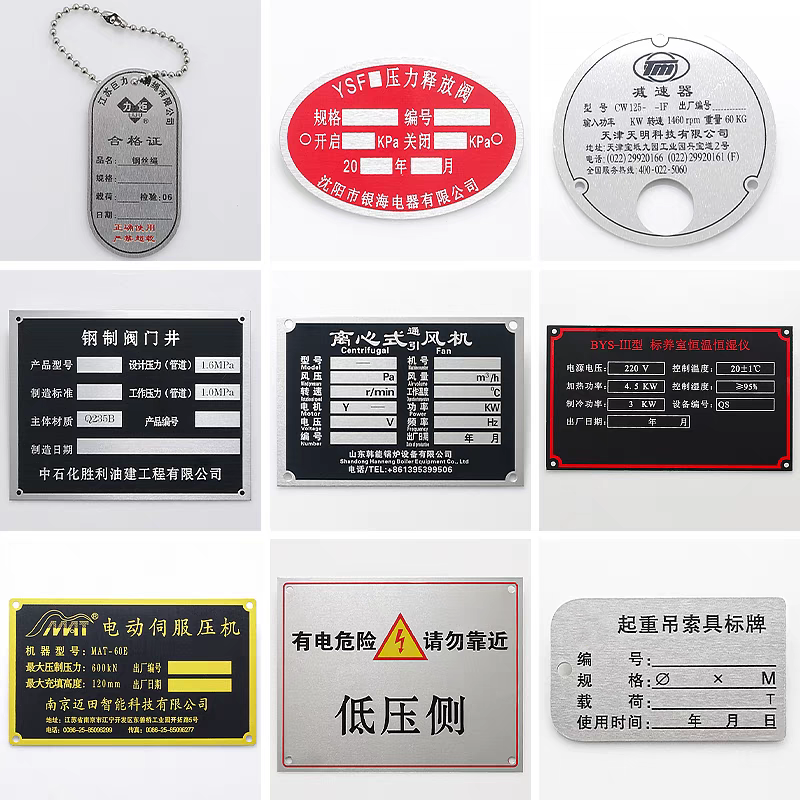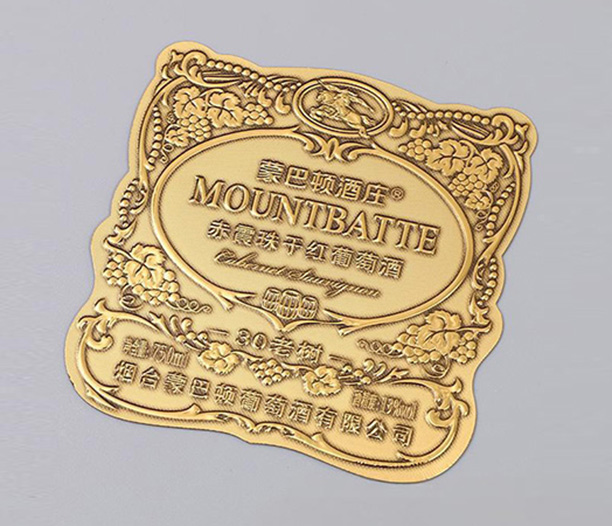In the bustling world of industrial operations, manufacturing plants, laboratories, healthcare facilities, and even modern offices, equipment forms the backbone of productivity. Yet, amidst the hum of machinery and the focus on core tasks, a seemingly simple element plays an outsized role in safety, efficiency, and organization: identification labels for equipment. These unassuming markers are far more than just stickers or tags; they are vital communication tools and data repositories. Understanding their multifaceted importance is crucial for any operation relying on physical assets. Let's delve into seven critical aspects that define the role and requirements of effective equipment identification labels.

1. Ensuring Regulatory Compliance & Meeting Standards
Perhaps the most non-negotiable function of identification labels for equipment is fulfilling legal and regulatory mandates. Numerous industries operate under strict frameworks that explicitly require clear equipment identification.
OSHA (Occupational Safety and Health Administration): Regulations like the Lockout/Tagout (LOTO - 29 CFR 1910.147) standard mandate specific labels to identify energy isolation points and procedures, preventing accidental startup during maintenance. Hazard Communication (HazCom - 29 CFR 1910.1200) requires labels on containers (including secondary containers) and often equipment handling hazardous chemicals, conveying critical hazard information via pictograms, signal words, and precautionary statements.
ISO (International Organization for Standardization): Standards like ISO 3864 govern safety signs and labels, including those on equipment. ISO 55000 (Asset Management) emphasizes the need for clear asset identification as a foundation for effective management systems.
Industry-Specific Regulations: NFPA (National Fire Protection Association) codes, ANSI (American National Standards Institute) standards (like Z535 for safety signs), FDA requirements for medical devices and food processing equipment, FAA regulations for aerospace components, and IEC standards for electrical equipment all dictate specific labeling requirements.
Consequences of Non-Compliance: Failure to implement compliant identification labels for equipment can result in severe penalties, fines, work stoppages, increased insurance premiums, and, most importantly, heightened risk of accidents and legal liability. Proper labels are the first line of defense in demonstrating due diligence.
2. Enhancing Workplace Safety & Preventing Accidents
Closely linked to compliance, but extending beyond it, identification labels for equipment are fundamental safety tools. They communicate critical hazards and instructions directly at the point of use.
Hazard Warnings: Labels clearly indicate dangers such as high voltage, extreme temperatures, crushing hazards, rotating parts, radiation sources, chemical exposure risks, and laser emissions. This immediate visual cue alerts personnel before interaction.
Operational Instructions & Limitations: Labels provide essential operating instructions, maximum load capacities, pressure ratings, flow directions, or required Personal Protective Equipment (PPE). Knowing the safe operating envelope prevents misuse and catastrophic failure.
Emergency Procedures & Shutdown: Critical labels indicate emergency stop locations, shutdown sequences, first aid instructions for specific hazards associated with the equipment, and fire suppression requirements.
Lockout/Tagout (LOTO): As mentioned under compliance, dedicated LOTO tags are a specialized form of equipment identification label, uniquely identifying the authorized employee who applied the lock and the reason for isolation, preventing accidental energization.
Reducing Human Error: Clear, unambiguous labels placed directly on relevant components minimize the risk of mistakes during operation, maintenance, or emergency response.

3. Enabling Efficient Asset Tracking & Inventory Management
Moving beyond safety, identification labels for equipment are the cornerstone of modern asset management systems. They provide the unique identifiers necessary to track an asset throughout its entire lifecycle.
Unique Asset Identification: Each piece of significant equipment receives a unique ID (serial number, asset tag number, barcode, QR code, RFID tag). This is the fundamental key for tracking.
Integration with CMMS/EAM Systems: Barcodes, QR codes, or RFID data on equipment identification labels seamlessly link physical assets to Computerized Maintenance Management Systems (CMMS) or Enterprise Asset Management (EAM) software. Scanning a label instantly pulls up the asset's complete history.
Tracking Key Data: Labels facilitate tracking of purchase date, cost, warranty information, location history, maintenance schedules, repair logs, parts replaced, calibration dates, depreciation, and current status (operational, under repair, decommissioned).
Audits & Inventory Control: Scanning asset labels during audits drastically improves speed and accuracy compared to manual checks. It simplifies inventory reconciliation and reduces the risk of lost or misplaced assets.
Lifecycle Management: Accurate tracking via labels allows for better forecasting of maintenance needs, replacement schedules, and optimizing the total cost of ownership.
4. Streamlining Maintenance & Repairs
Effective maintenance hinges on quickly identifying equipment and accessing relevant information. Identification labels for equipment are indispensable for maintenance teams.
Quick Fault Identification: Clear labels on components (motors, pumps, valves, control panels) allow technicians to swiftly locate the specific item needing attention, referenced in work orders or failure reports.
Accessing Maintenance History: Scanning a barcode or QR code on the equipment identification label instantly retrieves the asset's full maintenance history, past issues, repair procedures used, and parts lists. This provides invaluable context for diagnosing current problems.
Ensuring Correct Procedures: Labels often include model numbers, serial numbers, and manufacturer details critical for ordering the correct replacement parts or accessing the right service manuals and technical specifications.
Calibration & Certification Tracking: Labels clearly display calibration due dates, certification status (e.g., for lifting equipment or pressure vessels), and the identity of the last calibration technician or service provider. This ensures equipment remains within required tolerances.
Reducing Downtime: By enabling faster fault location, parts ordering, and access to historical data, proper identification labels for equipment significantly reduce mean time to repair (MTTR), minimizing costly operational downtime.
5. Improving Operational Clarity & Organization
On a day-to-day basis, clear identification labels for equipment contribute significantly to overall operational smoothness and organization, especially in complex environments.
Location Identification: Labels clearly mark equipment rooms, control panels, specific machines within a production line, storage tanks, utility points (electrical panels, water valves, gas lines), and workstation assignments.
Process Flow & Piping Identification: Color-coded labels and tape with flow direction arrows on pipes are crucial for understanding process flows, preventing cross-contamination (especially in food/pharma), and ensuring correct valve operation during startups, shutdowns, or emergencies. Standardized schemes like ANSI/ASME A13.1 are often used.
Cable & Wire Marking: Labels on cables, wires, and terminals within equipment and control panels are essential for safe installation, troubleshooting, modifications, and repairs, preventing dangerous misconnections.
Reducing Confusion & Errors: Clear labels prevent operators from using the wrong equipment, technicians from servicing the wrong machine, or emergency responders from shutting off the wrong valve. They provide instant visual context.
Training & Onboarding: Well-labeled equipment provides clear reference points for new employees during training, accelerating their familiarity with complex systems and procedures.
6. Durability & Material Selection: Withstanding the Environment
For identification labels for equipment to perform their critical functions reliably over time, they must be durable enough to survive their operating environment. Material selection is paramount.
Environmental Challenges: Labels face exposure to oils, greases, solvents, fuels, acids, alkalis, UV radiation, extreme temperatures (heat and cold), moisture, humidity, abrasion, impact, cleaning chemicals, pressure washing, and outdoor weathering.
Common Label Materials:
Polyester (PET): Excellent chemical resistance, durability, and temperature tolerance. Good for most industrial indoor environments. Often used with aggressive adhesives.
Vinyl: Flexible, good moisture resistance, and economical. Suitable for less harsh indoor environments or shorter-term applications. UV resistance varies.
Polyethylene (PE): Excellent chemical and moisture resistance, very flexible. Often used for drum and chemical container labeling. Good for curved surfaces.
Polyimide (Kapton): Exceptional high-temperature resistance (often exceeding 500°F/260°C), used in electronics, aerospace, and engine compartments.
Anodized Aluminum/Metal Tags: Extremely durable, resistant to extreme heat, chemicals, abrasion, and physical impact. Often used for permanent asset ID plates, nameplates, and safety labels on heavy machinery. Can be etched or printed.
Tamper-Evident Materials: Foils or destructible vinyls that show visible damage if removal is attempted, crucial for security or calibration labels.
Adhesive Selection: Just as important as the face material. Adhesives must be chosen to bond permanently to the specific surface material (metal, plastic, painted, powder-coated, textured) and withstand the environmental stresses present (heat, cold, chemicals).
Protective Overlaminates: A clear polyester layer applied over the printed label provides an extra barrier against abrasion, chemicals, UV fading, and moisture, significantly extending label life.
7. Customization & Information Delivery Methods
Modern identification labels for equipment offer a wide array of customization options and technologies to deliver information effectively, catering to diverse needs.
Variable Data Printing: Allows efficient printing of unique information (serial numbers, asset IDs, barcodes, QR codes) onto each label in a batch.
Barcodes (1D): Linear barcodes (like Code 128, Code 39) are cost-effective and widely used for quick scanning of asset IDs or part numbers into databases.
QR Codes (2D): Can store significantly more data than 1D barcodes, including URLs linking directly to online documentation, manuals, maintenance history, parts lists, or instructional videos stored in a CMMS or cloud repository.
RFID (Radio Frequency Identification): Tags embedded in or attached to labels allow contactless scanning, even without line-of-sight, and can be read through paint, dirt, or other obscurants. Ideal for tracking assets in bulk or in hard-to-reach locations. Data can be read/write enabled.
Color Coding: Using standardized or company-specific color schemes instantly conveys information – hazard levels (red/yellow), status (green/red for operational/out of service), pipe contents, safety zones, or department ownership.
Pictograms & Symbols: Universally understood symbols (ISO 7010) transcend language barriers, conveying hazards (flame, skull, exclamation mark), mandatory actions (ear protection, safety glasses), prohibitions (no smoking), or equipment functions quickly and effectively.
Text & Language: Clear, concise, and legible text in the appropriate language(s) is essential for instructions, warnings, and identification. Font size must be appropriate for the viewing distance.
Size & Placement: Labels must be large enough to be easily read from a safe distance and placed in a logical, prominent location relevant to the hazard or information they convey, avoiding moving parts or surfaces prone to wear.
Identification labels for equipment are far from an afterthought; they are a fundamental component of safe, efficient, compliant, and well-managed operations. From preventing catastrophic accidents and ensuring regulatory adherence to enabling precise asset tracking, streamlining maintenance workflows, and bringing clarity to complex environments, their impact is profound.
Investing in high-quality, durable, and well-designed identification labels for equipment, tailored to the specific environmental challenges and information needs of your assets, yields significant returns. It enhances safety culture, reduces operational risks and downtime, improves maintenance efficiency, simplifies audits, and provides critical data for informed decision-making throughout an asset's lifecycle. In the intricate dance of modern industry, clear and durable identification is the essential step that keeps everything running smoothly and safely. Don't underestimate the power of the label.






